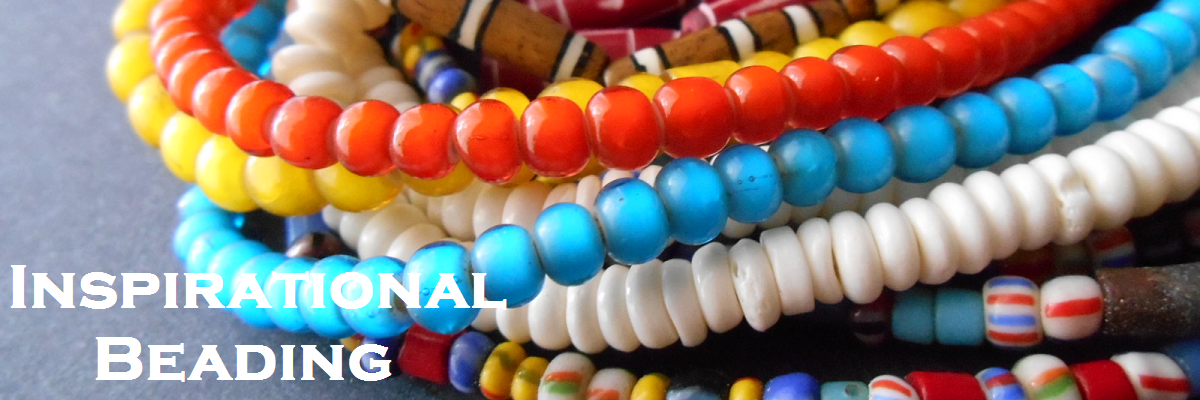To get the hang of this stitch, it can help to split your perception of the pattern three ways: the daisies, with a row of ‘leaves’ between each; a repeating pattern of 2- and 3-bead rows; and the actual thread path, which is also worked in a repeating 2-3 pattern. It sounds more complicated than it actually is - all you have to do is remember the correct sequence of bead colors to make the daisy pattern come through.
You’ll need at least 3 seed bead colors - for the petals, leaves, and pollen.
To weave a Potawatomi daisy chain:
Pick up 4 petal beads, and 1 pollen bead. Leaving a tail of 6 inches or more, stitch back through the first bead again, moving towards the tail thread. Pull snug to form a cluster of beads.
Pick up 2 petal beads, and stitch down through the last petal bead picked up in the first step. Pull snug, and you should have a tiny daisy!
To continue, pick up 1 leaf, 1 petal, and 1 leaf colored bead. Stitch up through the second petal bead picked up in the previous step - the one just above the bead your thread is exiting.
Pick up 1 leaf and 1 petal bead, and stitch down through the petal bead picked up in the previous step. Pull snug after each stitch, but don’t worry if the flowers don’t look perfect right away. With each new stitch, the previous row will get stronger and more even.
Pick up 2 petal and 1 pollen bead. Stitch up through the top petal bead in the work.
Pick up 2 petal beads, and stitch down through the second petal bead from the previous step, just below the pollen bead.
You'll see that once the first flower you stitch is complete, all of the steps will repeat with 2 and 3 beads picked up in each stitch, in the following pattern:
1 leaf, 1 petal, 1 leaf
1 leaf, 1 petal
2 petal, 1 pollen
2 petals
Repeat
Happy beading!
Copyright 2012 Inspirational Beading
Subscribe to Inspirational Beading
Get inspired on Facebook







This is such a sweet pattern! Thanks for the great tutorial.
ReplyDeleteLove this one, Mortira! Thanks.
ReplyDeleteBrings back memories - remember making these daisy chains in college during the Flower Power days :) Am going to have to try this, Morti! Thanks for the instructions.
ReplyDeleteI'm going to have to give that a try. It seemed like such a drab and boring stitch but making daisies just brightened up the whole look of it! TFS
ReplyDeleteThis is so cute!I love your colors. Is the white bead an opal white? Thanks for the tutorial. :)
ReplyDeleteThanks everyone! It's an incredibly fun stitch to do, and great for light but sturdy necklace straps.
ReplyDeleteThe white beads are Ceylon Pearl by TOHO - a very nice white that's not too stark or busy.
Thanks so much for the wonderful tutorial. I was just wondering, what thread are you using? Thanks again. My first time beading without a loom or crocheting, and it's a lot easier than I thought it would be, thanks to you!
ReplyDeleteI always use Fireline 6lb test for beadweaving, and even for multi-strand pieces. I love how easy it is to knot, and there is very little stretch.
ReplyDeleteHow do you join the ends of the bracelet?
ReplyDeleteHi Bonnie! In theory, you could create a continuous chain by incorporating the first "flower" into the final set of "leaves". Instead of picking up 1 leaf, 1 petal, 1 leaf in the final set, pick up 1 leaf, stitch through one of the petal beads from the first "row", and pick up one leaf. In the next stitch, instead of picking up 1 leaf and 1 petal, pick up 1 leaf, and stitch through the second petal from the first row.
DeleteThank you so much. I am a decendant of the Potawatomi Indian tribe. This is nice to see some of the work my ancestors did. I love beading and want to get started making a bracelet and necklace right away.
ReplyDeleteHi Monica! I'm so glad that you like the tutorial. It is a really fun stitch once you get the hang of it, and makes for very pretty beadwork.
DeleteWhat size seed beads do you use?
ReplyDeleteFor the chain above I used 8/o seed beads. 11/o beads will work of course, though anything bigger than 8/o and tension could be tricky.
DeleteI think u just made my best friend happy. Hope she will be. I only make brick stitch earrings, but she bugs me to make her bracelets. I've made her those simple 2 row bracelets where u just go back n forth, but one broke. This is nice n easy! Thanks!
ReplyDelete